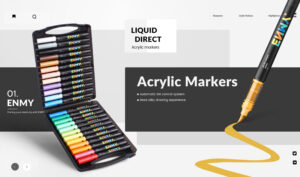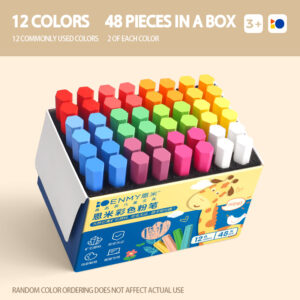In the expansive realm of art supplies, acrylic markers have emerged as a rising star in recent years. Their unique advantages have swiftly earned them the favor of numerous art enthusiasts, professional artists, and creative minds. What exactly makes acrylic markers so appealing? Let’s delve into the details.

Unveiling Acrylic Markers
Acrylic markers are art tools filled with water-based acrylic pigments, designed with nibs that allow for smooth application on various surfaces. Their key strengths are remarkable:
- Vibrant Color Palette: They offer an extensive range of colors with high saturation. Whether it’s bright and vivid hues or deep and rich tones, acrylic markers can precisely render them, infusing artworks with vivid life.
- Exceptional Layering Effect: Different colors can be freely layered, enabling artists to effortlessly create unique light, shadow, and texture effects, significantly enriching the depth and three-dimensionality of the artwork.
- Wide Surface Compatibility: From regular paper to special materials like wood, fabric, glass, and plastic, acrylic markers adapt well to various surfaces, fully meeting the diverse creative needs of artists and truly making “everything paintable.”
- Waterproof and Durable: Once the paint dries, it forms a waterproof and light-resistant film, effectively withstanding daily wear, sunlight, and humidity, thus maintaining the vibrancy and integrity of the artwork over time.
Distinctive Features of Acrylic Markers
- Superior Color Performance: Compared with traditional watercolor and oil paints, acrylic markers deliver more vivid and bright colors that stand out under light. Most brands on the market offer a wide array of colors, ranging from basic shades to special ones, such as metallic and fluorescent colors, adding unique highlights to creations.
- Rapid Drying: Acrylic markers dry much faster than traditional acrylic paints. Typically, the paint dries within a few minutes, greatly enhancing the creative efficiency. This makes them especially suitable for fast-paced projects and scenarios where quick color layering and effect building are required.
- Strong Coverage: These markers have excellent covering power. Even when applied to dark or pre-painted surfaces, they can easily cover the original colors, ensuring that the newly painted colors stand out clearly. This feature allows artists to freely correct their work or create new patterns over complex backgrounds, bringing more convenience and possibilities to the creative process.
- Versatile Stroke Effects: Depending on the nib shape and material, acrylic markers can produce a variety of stroke effects. Fine nibs are ideal for delicate line drawing and texture detailing, while broad and soft nibs are great for quick large-area coloring. By controlling the pressure and angle, artists can create dynamic strokes, endowing artworks with unique styles.
Diverse Applications of Acrylic Markers
- Artistic Creations: In illustration, acrylic markers can accurately present fine lines and rich colors, vividly shaping characters and scenes, adding unique artistic charm to illustrations. When creating large murals, their excellent coverage and rich colors ensure a vibrant and detailed result, and they are easy to use on different wall materials. In contemporary art, the combination of acrylic markers with other materials offers endless possibilities for artists to explore new forms of expression.
- Handmade DIY Projects: In the field of handicrafts, acrylic markers have extensive uses. They can be used to decorate notebooks and bullet journals, drawing beautiful patterns and writing personalized texts to make them unique. For clothing upcycling, creating original designs on T-shirts and canvas bags gives them a fresh, trendy look. When making wooden crafts or ceramic ornaments, acrylic markers can be used for coloring and detailing, enhancing the artistic value of the works.
- Educational Settings: In art education, the user-friendly nature and rich colors of acrylic markers can fully stimulate students’ creativity and imagination, helping them quickly master skills like color application and composition. In kindergarten and primary school classrooms, painting activities with acrylic markers can cultivate children’s interest in art and develop their practical abilities and color perception.
Differences from Regular Markers
- Pigment Composition: Acrylic markers use acrylic pigments, which are waterproof, durable, and have strong coverage. Regular markers usually use alcohol or water-based dyes, with relatively weaker durability and covering power.
- Color Performance: Acrylic markers offer more vivid and highly saturated colors with richer color layers. Regular markers are less vivid in color, and their color mixing effects are relatively limited.
- Suitable Surfaces: Acrylic markers work well on a wide range of surfaces, including paper, fabric, wood, plastic, and glass. Regular markers are mainly suitable for paper, and their adhesion and performance on other materials are not as good.
- Drying Speed and Water Resistance: Acrylic markers dry quickly, and they are highly water-resistant after drying. Regular markers dry even faster, but their water resistance varies by type, and overall, their waterproof effect is not as good as acrylic markers.
- Price: Due to differences in pigment costs and manufacturing processes, acrylic markers are generally more expensive than regular markers. However, considering their excellent performance and wide applicability, they still offer good value for money.
Practical Tips for Selecting and Using Acrylic Markers
Selection Tips
- Determine Your Needs: For daily drawing and doodling, choose an affordable basic set with a rich color range. For professional art creation, pay attention to factors such as color accuracy, coverage, and ink capacity, and opt for professional-grade products. When selecting markers for children, prioritize nib safety and ink non-toxicity.
- Consider Nib Types: Fine nibs are good for line drawing and detailing, round nibs are suitable for quick large-area coloring, and soft nibs can produce different line thicknesses by varying pressure and angle, creating diverse stroke effects. Choose according to your drawing habits and creative needs.
- Check the Color Set: A high-quality set of acrylic markers should include primary colors (red, yellow, blue) and basic colors like black and white to meet basic color mixing needs. If you have specific creative requirements, choose products with special colors such as metallic and fluorescent shades.
- Understand Ink Characteristics: Pay attention to the ink storage method, quick-drying property, water resistance, and layering ability. For example, markers with a direct liquid control valve design offer more even ink flow and larger ink capacity. Markers with good quick-drying and waterproof properties can improve creative efficiency and ensure the longevity of the work.
- Choose Reputable Brands: Give preference to well-recognized brands with good market reviews. Check if the products have passed relevant quality certifications to ensure safety and reliability.
Usage Tips
- Shake Well Before Use: In some acrylic markers, the pigments may settle. Shake the marker up and down before use to evenly mix the pigments, ensuring smooth ink flow and consistent color.
- Paint from Light to Dark: This makes it easier to control the color layers of the artwork and avoid color muddiness when darker colors cover lighter ones.
- Explore Layering Techniques: Experiment with different color combinations and layering orders to discover unique color effects. Make sure the previous layer is completely dry before applying a new layer to prevent uncontrolled color mixing.
- Maintain the Nib: Always cap the marker immediately after use to prevent the nib from drying out and deforming. If too much paint accumulates on the nib, gently wipe it with a clean paper towel.
- Remove Stains Effectively: If the paint gets on clothes or skin, wash it off with soap and water as soon as possible while the paint is still wet. For dried paint, try using alcohol or a specialized cleaner.
With their unique charm, acrylic markers bring boundless possibilities to creative expression. Whether you are a professional artist or an amateur enthusiast, you can find inspiration and joy in using acrylic markers. It is hoped that this introduction will deepen your understanding of acrylic markers, enabling you to fully leverage their advantages and create stunning artworks in the future.





